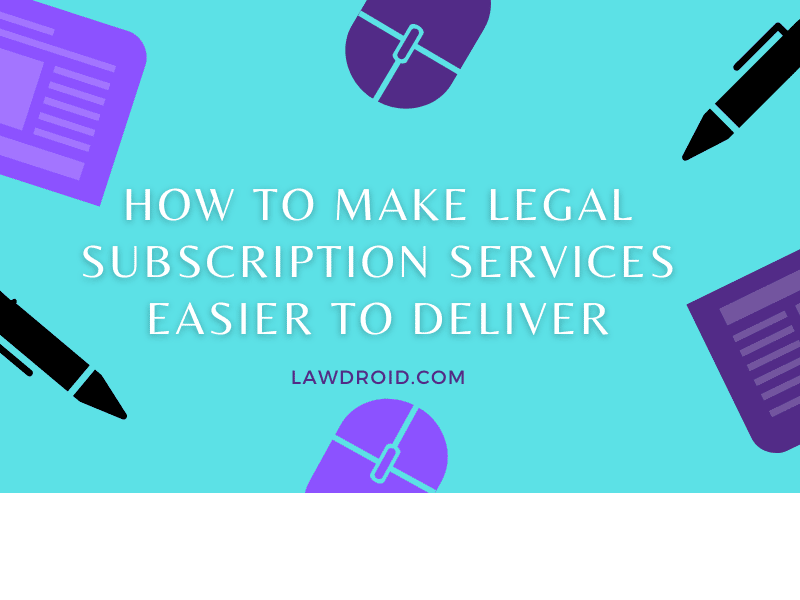Legal subscription services are a hot commodity for many law offices. Yet, others haven’t heard of them. What are they? How can they help the public? Could changing how your law firm offers legal services help improve operations or profit? If you’re already providing subscription legal services, can you improve who you’re delivering them?
This blog post serves as a basic guide to answer those questions. We hope you enjoy it. If you have any questions after you read this blog, schedule your demo with LawDroid to learn how our no-code solution can solve the delivery problems and automation needs that exist for subscription based law firms.
What Are Legal Subscription Services?
Legal subscription services are legal services offered by law firms or solo lawyers. Clients agree to some form of an innovative subscription model to receive legal services. The law firm or solo lawyer may provide various types of legal services, depending on the areas they practice. Maybe they offer document review, unlimited legal advice, maybe they become part of the board for a nonprofit, or maybe they provide tax advice. In addition to the services received as part of the subscription-based legal services, the law firm may also provide a discount to their clients for a la carte legal services.
How Innovative Subscription Models Help the Public
Even a small subscription legal services plan that only offers a few services that the public could use that are affordable is beneficial to the public. They receive access to some legal assistance or legal forms, even if they will not be represented in court at a price they can afford. It’s a model that also is helpful for small businesses, micro-businesses, and startups, especially those owned by women and other minorities who may not have the same opportunities for funding or access to legal professionals or legal forms.
How Offering Subscription Legal Services Help Your Law Firm
Believe it or not, offering subscription legal services can help your law firm. This isn’t a matter of dropping all of your other legal services. It can be a profitable addition to your law firm. You can start with one or two services that are easy for you to provide and that are in demand. Take a look at the legal services that you provide and decide which may be good as a la carte legal services and which should become the center of your new innovation subscription model.
Making the Delivery of à la carte Legal Services and Legal Subscription Services Easier
Certain types of a la carte legal services and legal subscription services need to be delivered over the phone or perhaps in person. For example, if you work with non-profit organizations or with corporations that secured you to provide advice to board members or even to sit on their board, you may need to be involved via Zoom or in-person, depending on the location of the client.
Automated Legal Document Drafting
Depending on what becomes part of your subscription legal services or a la care legal services plan, you may be able to add automation or document drafting software. Various types of legal automation, along with document drafting software, can improve the efficiency of providing your legal subscription services, allow you to provide these services faster, and give you the power to draft documents faster (and with more accuracy).
Related: Automated Legal Forms: Should Personal Injury Attorneys Use Them?
And, as mentioned earlier, you’re also providing access to legal for the public at a reduce rate. For example, if you provide a la carte legal services by implementing document drafting software as a family law attorney, the public may have access to divorce petitions for uncontested divorces with or without minor children for a lower fee. Of course, they wouldn’t be represented by you and that would need to be made clear. You could include a disclaimer on your website and on a page that is generated by the legal automation software that creates the documents.
Legal Chatbots
Legal chatbots are another example of how you can provide automated legal services. You’ve seen the LawDroid law bot here on our site. Ours includes a video of Tom, our founder. Legal chatbots can do a lot of things. It can be on your website so that it can answer questions that website visitors may have. Legal bots can be used by people who purchase forms from you. They interact with the law bot to provide their information. The law bot transfers their information to the automated legal document software. They can also be used to deliver the completed legal documents. A law bot can also be used to provide clients with answers to common legal questions.
Learn More about Legal Automation and the Delivery of Legal Subscription Services
The automation of legal services for your legal subscription services can be customized if you work with the right legal tech provider. What was covered here are basic options to make providing subscription services easier for you. Here at LawDroid, we provide a no-code solution for our clients. If you’re ready to explore how your law firm can provide legal subscription services and a la carte legal services while keeping the process easy on yourself, schedule your free demo!

Tom Martin is a legal AI advocate, lawyer, author and speaker.
He is CEO and founder of LawDroid, a Generative AI Legal Technology company, and co-founder of the American Legal Technology Awards.
Tom has been recognized as an ABA Legal Rebel and Fastcase 50 Honoree.
Tom has presented as a speaker at ABA Techshow, LegalWeek, ILTACON, Clio Con, Legal Innovators, and many others. Tom’s writing has been published in the ABA’s Law Practice Today, Law Technology Today and GP Solo Magazine, to name a few; he has also been featured on numerous podcasts, including Legal Rebels, Un-Billable Hour, Lawyerist, the Digital Edge, and New Solo.
Tom also has his own podcast: LawDroid Manifesto on iTunes. Subscribe to his Substack at lawdroidmanifesto.com.
He serves as a mentor at the Yale Tsai Center for Innovative Thinking and ATJ Tech Fellows. Tom is a graduate of Yale and UCLA School of Law.
Born and raised in Los Angeles, California, Tom now lives in Vancouver, Canada with his wife and two daughters.

